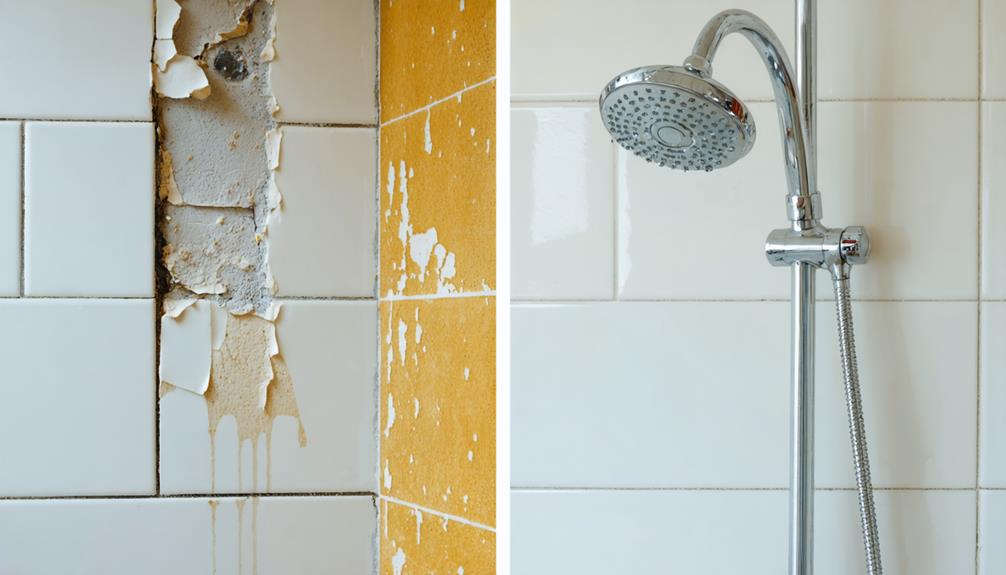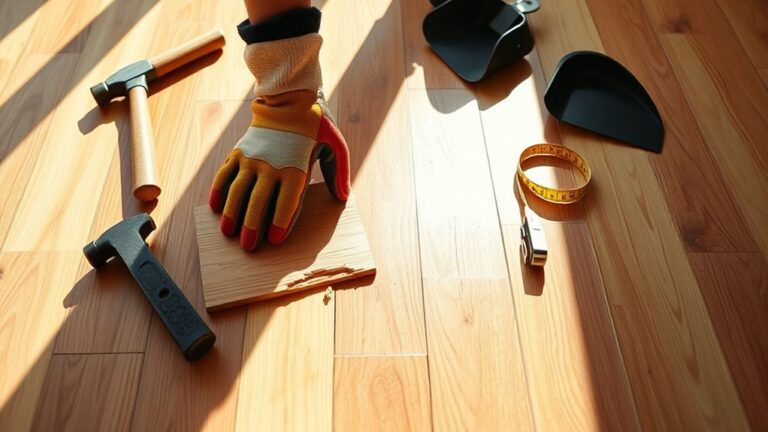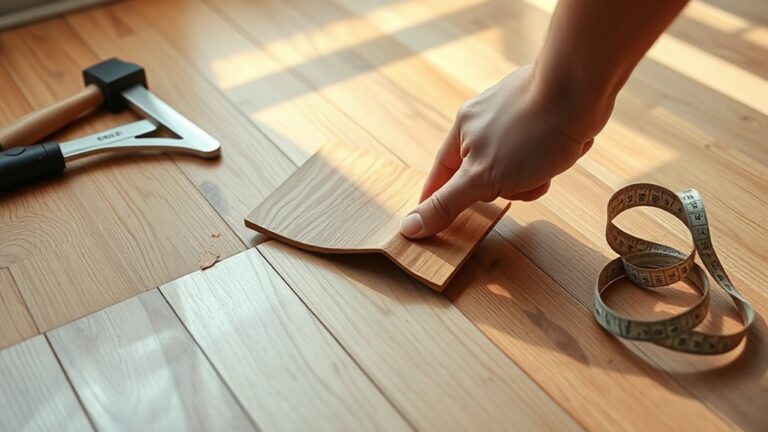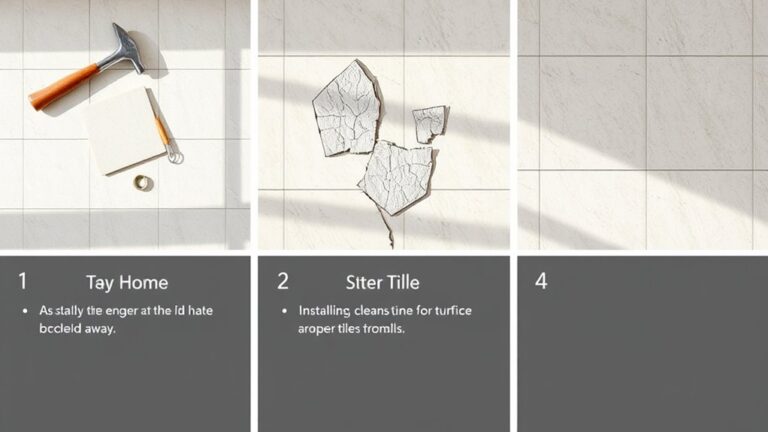To avoid common waterproofing mistakes in bathrooms, guarantee thorough surface preparation before application. Select a waterproofing membrane that meets industry standards and is suitable for your specific environment. Follow manufacturer instructions carefully during application to maintain proper thickness and coverage. Don't overlook sealing at corners, joints, and penetrations, as these are critical areas for leaks. Ensure proper drainage with a minimum 2% slope to avoid water ponding. Finally, be patient with the curing process to maintain the integrity of your waterproofing system. There's more to mastering these techniques that could save you time and money in the long run.
Inadequate Surface Preparation
One common mistake in bathroom waterproofing is inadequate surface preparation, which can greatly undermine the effectiveness of the entire system. For waterproofing materials to function correctly, surfaces must be clean and sound to guarantee proper adhesion. If you neglect this significant step, you risk creating a weak bond that can lead to premature failure.
Before applying any waterproofing system, it's important to remove dirt, grease, and loose particles. Any contaminants left on the surface can compromise the bond and overall performance of the waterproofing solution. Additionally, pay attention to existing cracks or holes; repairing these weaknesses is imperative. If overlooked, water penetration can occur, ultimately leading to damage and costly repairs down the line.
Industry standards emphasize that thorough surface preparation is crucial for achieving long-lasting waterproofing. By adhering to these guidelines, you not only enhance the durability of your waterproofing system but also safeguard your investment. Failing to prepare surfaces adequately can result in a system that does not perform as intended, exposing your bathroom to potential water damage.
Incorrect Waterproofing Membrane Selection
Inadequate surface preparation can lead to a waterproofing system that fails to perform effectively, but choosing the wrong waterproofing membrane can be just as detrimental. Incorrect waterproofing membrane selection, especially for internal wet areas like bathrooms, can result in significant leaks and water damage. Membranes not specifically designed for constant moisture exposure often lack the fundamental properties required to withstand such conditions.
It's essential to comply with the National Construction Code (NCC) and Australian Standards when selecting waterproofing membranes. Materials that don't meet these standards may fail prematurely, leading to costly repairs. Proven options, such as liquid-applied membranes or sheet membranes, are critical for maintaining effective moisture management. If you choose improperly, you compromise their ability to provide a watertight seal, exposing your space to the risk of leaks.
Using a product selector tool can guide you in choosing the right waterproofing membrane based on your specific project requirements. This step is important for long-term waterproofing success. Data indicates that nearly 50% of showers experience leakage issues, often stemming from improper material selection. By avoiding this common waterproofing mistake, you can save yourself from future hassles and guarantee that your bathroom remains dry and functional. Remember, the right selection today can prevent significant problems tomorrow, so invest the time to make an informed choice.
Improper Application Techniques
When applying waterproofing materials, you must follow the manufacturer's instructions closely to avoid weak spots that can compromise the system. Using the right tools, such as brushes or rollers, guarantees even coverage, which is critical for preventing water infiltration. Remember, achieving the recommended thickness is key; both insufficient and excessive application can lead to failure.
Follow Manufacturer Instructions
Consistently following manufacturer instructions is fundamental for achieving effective waterproofing in bathrooms. These instructions provide significant guidelines on application techniques, including the required thickness for each coat. Neglecting this can lead to improper adhesion, which often results in leaks and waterproofing failures.
To guarantee even coverage and avoid weak spots, it's essential to use appropriate tools as recommended. Additionally, manufacturers include data sheets that detail necessary curing times and environmental conditions, which are imperative for ideal product performance.
Here's a quick reference table to guide you:
| Aspect | Importance | Consequences of Ignoring |
|---|---|---|
| Application Techniques | Guarantees proper installation | Weak waterproofing |
| Required Thickness | Prevents leaks | Water damage |
| Even Coverage | Reduces weak spots | Compromised integrity |
| Curing Times | Guarantees product effectiveness | Premature failure |
| Environmental Conditions | Guarantees ideal product performance | Increased risk of failure |
Use Proper Tools
Following manufacturer instructions is essential, but using the right tools during application is equally important for effective waterproofing in bathrooms. If you want to avoid common waterproofing mistakes, make certain you're equipped with the proper tools:
- Brushes and rollers for even coverage of waterproofing materials
- Trowels for applying thicker, trowel-applied membranes
- Notched trowels for enhanced bonding effectiveness with tiles
- Specialized application tools for specific tasks
Using proper tools helps guarantee adequate thickness and proper adhesion. Insufficient coverage can lead to weak spots, increasing the risk of leaks. When you select the right tools, you enhance your application techniques, which is vital for the integrity of your waterproofing system. For instance, using a trowel for thicker membranes ensures you achieve the necessary thickness while promoting proper adhesion.
Regular training on these specialized application tools can notably reduce errors and improve your project's success. Remember, the right tools are as important as the materials themselves; they can make or break your waterproofing efforts. Invest in quality tools and techniques to guarantee a long-lasting, leak-free bathroom.
Ensure Even Coverage
How can you guarantee even coverage in your bathroom waterproofing project? Achieving even coverage is crucial for a robust waterproofing system, as uneven application can create weak points that lead to water infiltration over time. Start by following manufacturer guidelines closely, ensuring you apply the specified thickness of waterproofing materials. This adherence will help you avoid insufficient or excessive application, both of which can cause premature failure.
Use appropriate tools like brushes or rollers designed for consistent application. These tools minimize the risk of missed spots that could jeopardize your waterproofing efforts. During the application process, real-time inspections are imperative. Regularly check the coverage as you work, allowing you to identify and correct any inadequacies before the system is finalized.
Always pay attention to the specified coverage rates outlined in product data sheets. Ensuring even coverage not only enhances the durability of your waterproofing system but also protects your investment against costly repairs down the line. By taking these steps, you'll create a resilient barrier against moisture, ensuring your bathroom remains dry and functional for years to come.
Lack of Proper Sealing
Neglecting proper sealing in bathrooms can lead to significant issues, as it serves as a critical barrier against water intrusion. A lack of proper sealing around penetrations such as pipes and drains can allow water to enter and damage surrounding structures, compromising the integrity of your entire waterproofing system. It's crucial to apply suitable sealants and techniques for achieving watertight results, especially at junctions where water is likely to penetrate.
Consider these key points when addressing sealing practices:
- Pay special attention to corners and joints, as they're often the most vulnerable areas for leaks.
- Guarantee thorough detailing around all penetrations to eliminate potential water damage.
- Use high-quality sealants designed for bathroom environments to enhance durability.
- Regularly inspect sealed areas to maintain their effectiveness over time.
Neglecting Drainage and Slope
Even with proper sealing, inadequate drainage and slope can lead to severe water-related issues in bathrooms. If you neglect to guarantee a proper slope towards drainage points, you risk ponding water, which can compromise the integrity of your waterproofing system. A minimum fall of 2% is essential in traditional mortar beds to facilitate effective moisture drainage and prevent water accumulation. Without this slope, trapped water can lead to mold growth and structural damage.
One common oversight is failing to create a pre-slope beneath the shower pan. This step is crucial for directing moisture towards the weep holes, which must remain unobstructed to allow moisture to escape. Blocked weep holes contribute to water retention and can ultimately lead to waterproofing failure. Regular inspections are important for verifying that your drainage systems and slopes are functioning correctly. These inspections can help you catch potential issues before they escalate into significant problems.
Overlooking Corners and Joints
When waterproofing your bathroom, don't underestimate the importance of corners and joints; these areas are particularly vulnerable to water seepage. It's vital to use compatible sealants and membranes to guarantee proper detailing, creating a reliable barrier against moisture. Regularly inspecting these junctions is essential to maintain the integrity of your waterproofing system and prevent costly damage.
Vulnerable Water Seepage Areas
Although it may seem minor, the detailing of corners and joints in bathrooms is critical to preventing water seepage. These vulnerable areas often experience higher water exposure, making them prime targets for leaks. Overlooking proper sealing at junctions between walls, floors, and fixtures can lead to severe water damage and mold over time.
Here are some key considerations to keep in mind:
- Verify corners and joints are meticulously sealed.
- Use a robust waterproof membrane installed in wet areas.
- Avoid creating penetrations that can compromise the waterproofing layer.
- Recognize common failures, especially at connections between walls and bases.
Proper Detailing Techniques
Proper detailing techniques are essential for guaranteeing your bathroom's waterproofing system remains effective, particularly at corners and joints, which are often overlooked. These areas are prone to water seepage, making it imperative to maintain waterproofing integrity. When detailing corners and joints, you must focus on adequate sealing to prevent leaks.
Effective waterproofing requires attention to the junctions between walls and floors, where failures commonly occur. It's critical to utilize appropriate sealants and techniques, especially at penetrations like pipes and drains. This guarantees watertight results, considerably reducing the risk of water damage and mold growth.
Don't underestimate the importance of inspecting these areas regularly after installation. Regular inspections can help identify potential vulnerabilities, allowing you to address issues before they escalate into costly repairs. By prioritizing proper detailing at corners and joints, you'll safeguard your bathroom from the detrimental effects of water seepage.
Essential Junction Attention
Focusing on corners and joints is vital in guaranteeing your bathroom's waterproofing system remains intact. These areas are significant points where water can easily seep through if not properly addressed. Neglecting to seal these junctions can lead to severe water damage and mold growth, resulting in costly repairs.
Here are key points to take into account:
- Use compatible sealants at corners and joints to create a watertight barrier.
- Verify membranes overlap adequately, reinforcing the waterproofing measures.
- Regularly inspect corners and joints for signs of wear or damage.
- Contemplate additional reinforcement, like corner beads or fabric, for enhanced durability.
Proper detailing at these junctions prevents future issues. Industry best practices recommend that all corners and joints be meticulously treated. Without attention to these vulnerable areas, your waterproofing efforts may be undermined. Regular inspections play a vital role in maintaining the integrity of your waterproofing system. By actively managing these details, you'll safeguard against potential water intrusion and preserve the longevity of your bathroom's structure. Prioritize the corners and joints to guarantee your bathroom remains a sanctuary, free from the perils of water damage.
Rushing the Curing Process
One of the most essential yet often overlooked aspects of waterproofing bathrooms is the curing process of the membranes. Rushing the curing process can seriously compromise the integrity of your waterproofing system, leading to potential leaks and failures. Most manufacturers specify curing times that range from 24 hours to several days, depending on the product used. Ignoring these guidelines increases the risk of suboptimal performance.
A fully cured membrane is important for guaranteeing proper adhesion to the substrate and maintaining effective moisture barrier capabilities. This is critical for achieving long-lasting waterproofing that can withstand the demands of a bathroom environment. If you apply finishes or tiles over the waterproofing membranes before they've had adequate time to cure, you risk damaging the system and undermining its effectiveness.
It's essential to exercise patience during the curing phase. This stage plays a significant role in the overall durability and success of your waterproofing installation. Taking shortcuts may seem tempting, especially when you're enthusiastic to complete your project, but the consequences can be severe. By allowing adequate curing times, you guarantee that the membranes achieve their full potential, which ultimately safeguards your bathroom from water damage. Remember, investing time in this process now can save you from costly repairs in the future. So, prioritize the curing phase and enjoy the peace of mind that comes with a properly waterproofed bathroom.
Ignoring Professional Guidance
Neglecting professional guidance when waterproofing bathrooms can lead to a myriad of problems that compromise the integrity of the installation. Engaging waterproofing professionals guarantees that you're not just avoiding common pitfalls, but also adhering to necessary building codes. Without their expertise, you risk facing significant issues, like leaking showers and premature deterioration.
- Experience Matters: Professionals know how to identify and manage common pitfalls that DIYers often overlook.
- Material Selection: Experts can recommend the right materials for specific wet areas, guaranteeing longevity and functionality.
- Quality Control: Professional oversight enhances quality control, assuring thorough inspections and adherence to best practices.
- Compliance Assurance: Compliance with building codes is essential for achieving long-lasting waterproofing results.
Remember that approximately 50% of showers in the U.S. experience issues due to improper installation practices. This highlights the importance of consulting with professionals who can guide you through the installation process. They not only offer valuable insights into appropriate installation practices but also guarantee that you select the right materials tailored to your bathroom's unique needs.
Frequently Asked Questions
When Waterproofing Is Installed Incorrectly?
When waterproofing's installed incorrectly, it can lead to costly damage. You might overlook surface preparation, affecting the effectiveness of moisture barriers. Using improper installation materials or neglecting sealant application can compromise drainage systems. Common misconceptions often lead to inadequate inspection methods. Always consider cost implications when choosing waterproofing techniques, as poor practices can escalate maintenance practices. Remember, ensuring proper installation isn't just about freedom from leaks; it's about extending your investment's lifespan.
What Are the Failures of Waterproofing?
Waterproofing failures often stem from improper installation techniques, inadequate surface preparation, and the choice of incompatible waterproofing materials. If moisture barriers aren't correctly applied or seam sealing is overlooked, leaks can occur. Additionally, poor drainage systems and ventilation issues can lead to moisture accumulation, resulting in mold growth and structural damage. The cost implications of these failures can be significant, emphasizing the importance of proper installation and long-term maintenance for effective waterproofing.
How Do You Know if Waterproofing Has Failed?
If you're noticing signs of waterproofing failure, it can feel like a nightmare. Look for moisture detection clues like mold growth, stained ceilings, or peeling paint. Efflorescence appearance and grout deterioration might indicate water damage lurking beneath. Musty odors often signal hidden moisture, leading to structural issues. If you see delaminating tiles or persistent dampness, it's time to address potential waterproofing failures before the situation escalates. Don't wait until it's too late!
How Many Coats of Waterproofing Does a Bathroom Need?
When waterproofing a bathroom, you'll typically need two to three coats of waterproofing materials for ideal protection. Pay attention to application techniques and make sure you're adhering to drying times between coats. Proper surface preparation is vital to avoid issues later. Consider product selection carefully, as cost considerations can impact long-term maintenance. Remember common myths about waterproofing; environmental factors also play a role, so consulting professional services might be beneficial for best outcomes.




